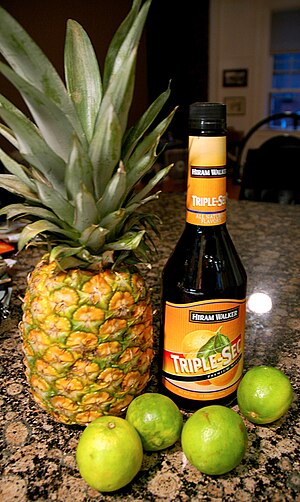Triple sec
 | |
| Type | Liqueur |
|---|---|
| Country of origin | France |
| Introduced | 19th century |
| Alcohol by volume | 15% to 40%[1] |
| Color |
|
| Flavor | Orange |
Triple sec is an orange-flavoured liqueur that originated in France. It usually contains 20–40%[2] alcohol by volume.
Triple sec is rarely consumed neat, but is used in preparing many mixed drinks such as margaritas, cosmopolitans, sidecars, Long Island iced teas, and mai tais.
Etymology
The origin of the name "triple sec" is disputed. Many sources claim it comes from a triple distillation process used to create the liqueur,[3][4][5] but others say that a triple distillation is not used.[6] Several sources say that the term is a translation of the French sec, which can mean both "distilled" and "dry".[6][7] Cointreau, a brand of triple sec, claims to have invented the term based on the three types of orange peels used in the liqueur.[3][5]
History
Triple sec has been popular for more than 150 years. The Dutch East India Company created orange liqueurs by steeping dried orange peels from places such as the island of Curaçao.[8] They called this "Curaçao liquor", and unlike triple secs, which contain only the flavor of orange peel, the Dutch version includes herbs and spices, and comes in a variety of colors such as clear, orange, or blue.[9]
The Combier distillery claims that Jean-Baptiste Combier and his wife Josephine invented triple sec in 1834, in their kitchen in Saumur, France.[10] Orange liqueur was rising in popularity after the Dutch introduced Curaçao, and the Combiers sought to create a version that would be true to the orange fruit, they wanted it to be crisp and clean, with orange essential oils as the main feature. To achieve this, the Combier family used bitter oranges that were native to Haiti, and sweet Valencia oranges to balance the flavor.[11] The liqueur was made by sun-drying the various orange peels. After at least 48 hours, they would begin distilling this mixture in copper pots. Lastly, they would put them through a third distillation, to purify the flavor.[12]
In 1875, Cointreau created its version of triple sec and calls itself one of the most popular brands.[13] Triple sec gained popularity and was widely known by 1878; at the Exposition Universelle of 1878 in Paris, several distillers were offering "Curaço [sic] triple sec", as well as "Curaço doux".[14]
A variant of triple sec is Grand Marnier, which uses brandy as a base, giving it a distinctive heavier and earthy flavor.[citation needed]
Production
Triple sec is usually made from orange peels steeped in a spirit derived from sugar beet due to its neutral flavor. Oranges are then harvested when their skin is still green and they have not fully ripened, so the essential oils remain in the skin and not the flesh of the fruit. This spirit is then redistilled and mixed with more neutral spirit, water, and powdered beet sugar resulting in the final liqueur. This process creates a spirit that has a very strong and distinct orange flavor.[3]
See also
References
- ^ "Triple Sec". Bar None Drinks. Retrieved 30 July 2018.
- ^ "Triple sec liqueurs". www.diffordsguide.com. Retrieved 2022-01-20.
- ^ a b c Difford, Simon. "Triple sec liqueurs". Difford's Guide. Retrieved 18 January 2022.
- ^ "Triple Sec". Bar None Drinks. Retrieved 18 January 2022.
- ^ a b "Difference Between Curaçao, Triple Sec & Orange Liqueur Explained". Senior & Co. Retrieved 18 January 2022.
- ^ a b McKirdy, Tim (3 December 2021). "What's the Difference Between Cointreau, Grand Marnier, Curaçao, and Triple Sec?". VinePair. Retrieved 18 January 2022.
- ^ "The Insider's Guide to Triple Sec". Cocktail Builder. Retrieved 18 January 2022.
- ^ "Triple sec liqueurs". www.diffordsguide.com. Retrieved 2021-05-12.
- ^ "Triple sec liqueurs". www.diffordsguide.com. Retrieved 2021-05-12.
- ^ "Original Combier". Combier. Retrieved 31 July 2018.
- ^ "The Combier Story // History // Combier Liqueurs". www.combierusa.com. Retrieved 2021-05-12.
- ^ "The Combier Story // History // Combier Liqueurs". www.combierusa.com. Retrieved 2021-05-12.
- ^ "Cointreau". Rémy Cointreau. Retrieved 30 July 2018.
- ^ The Lancet Analytical Commission, "Report on the Food Products exhibited in the French and English Departments of the Universal Exhibition of Paris", The Lancet, 21 September 1878, p. 417f.